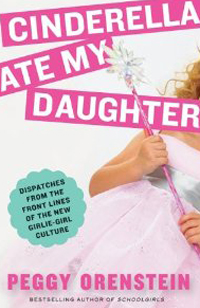Upon receiving a review copy of Peggy Orenstein’s latest book, Girls and Sex: Navigating the Complicated New Landscape, from her publicist at HarperCollins, I recalled another book of hers I really enjoyed, Cinderella Ate My Daughter. Here is a look back at reviewer Deborah Spitz’s review of Cinderella Ate My Daughter; stay tuned for my review of Girls & Sex!
Review of Cinderella Ate My Daughter
by Deborah Spitz
This book by Peggy Orenstein will definitely get you thinking about what influenced you as a child and how girl-culture has changed since then. Orenstein has been researching girls, education, and self-esteem issues for years. She is now a parent, and in this book she talks about her challenges of raising her own daughter in a gender-positive way.
Forty years ago, products like Barbies, makeup, and clothes were marketed to teenagers. Twenty years ago they were marketed to “tweens,” and now they are aimed at your three year old. If you have a daughter you know that those “Disney Princesses” are everywhere. They were created in 2001, when a Disney executive went to a party and saw lots of little girls in homemade princess costumes. He realized then that “every girl wanted to be a princess” and who better than Disney to market it to them?
As a parent, Orenstein struggles with how much princess is too much. She considers whether it’s the fairy tales that bother her or just the cutesiness of it all. The parents she interviews respond, “I don’t want my kids to know the stories, since the princesses are just these helpless girls who get rescued by princes, but I don’t mind them feeling pretty and special.”
Actually, Orenstein and child development experts come to the opposite conclusion. In the fairy tales, the characters have context – they overcome adversity and solve problems. With the princess merchandise, it’s all about appearance. The princesses just stare out at you from dishes and backpacks but they never actually interact with anyone. In fact, the whole princess idea is that the princess stands alone. She is special and unique, but she also has no girl friends.
Some of today’s “girl culture” comes from today’s mothers. Many women in the 70s tried to raise their daughters in a more “gender-neutral” way, rejecting girly toys and minimizing emphasis on appearance. They themselves were rebelling against the strict gender roles of the 50s. Unfortunately, gender-neutral can also feel like a suppression of female identity. Today’s moms told Orenstein they wanted their daughters to feel beautiful and special, to celebrate girlhood.
Orenstein is concerned that today’s “pink-and-sparkly” culture will cut girls off from boys at an age where children should be interacting freely. We expect children to segregate by gender at a certain age. But in the preschool years their brains are still developing, and play with both genders is important. Studies also show that girls raised with older male siblings have an easier time forming quality relationships with men later on.
This great parenting book will give readers a lot to think about when it comes how these things influence girls and women. It’s a stimulating work in the realm of parenthood books that reflects how there is no “right” approach to the challenges of raising young girls.
Deborah thanks for the review!~Find her at The Book Stop~!
Stay tuned for my review of Girls & Sex!
Updated from original post 2011

